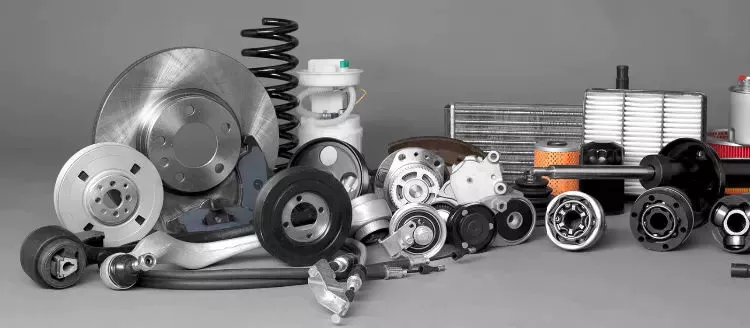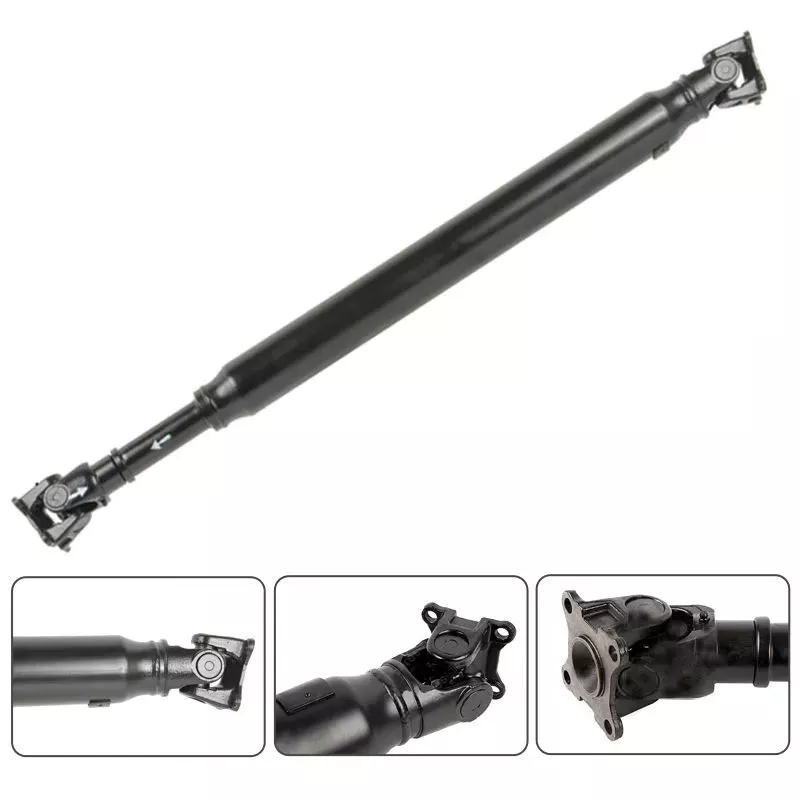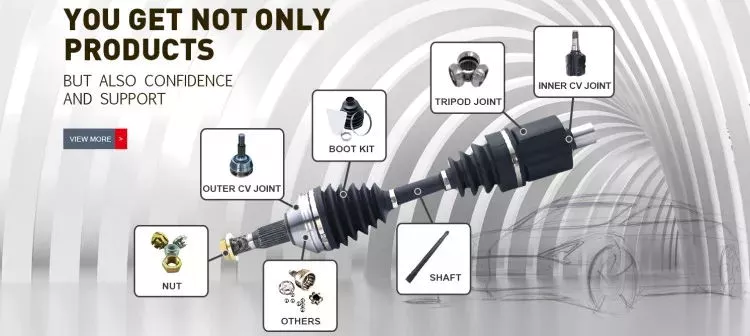Product Description
| PRODUCTS INFORMATION |
| Item Name | EEP Brand Auto Parts Drive Shaft & Axle |
| Part Number | OE code or car chassis number |
| Car model | for CZPT Honda CZPT Mazda CZPT CZPT CZPT Subaru |
| Brand | EEP/OEM |
| Warranty | Different brands, different warranty time; CZPT brand, 1 year |
| Packing | EEP brand nylon bag & box or as Customer’s Requirements |
| Size | Standard |
| MOQ | 10 Pcs |
| Payment | L/C, T/T, Western Union, Other (Cash) |
| Delivery | 1-7 days for stock items, 10-25 days for production items |
| Sample | Available |
| Certificate | ISO9001, TS16949, SGS |
| After-sales Service: | Standard |
|---|---|
| Condition: | New |
| Color: | Silver, Black |
| Certification: | CE, ISO |
| Type: | Drive Shaft/CV Axle Shaft |
| Application Brand: | Nissan, Toyota, Ford, Honda/Mazda/Mitsubishi |
| Customization: |
Available
| Customized Request |
|---|

What maintenance practices are essential for prolonging the lifespan of driveline components?
Implementing proper maintenance practices is crucial for ensuring the longevity and optimal performance of driveline components. Regular maintenance helps identify potential issues, prevent major failures, and prolong the lifespan of driveline components. Here are some essential maintenance practices for prolonging the lifespan of driveline components:
1. Regular Inspections:
Performing regular visual inspections of driveline components is essential for detecting any signs of wear, damage, or misalignment. Inspect the driveline components, including driveshafts, universal joints, CV joints, differentials, and transmission components, for any cracks, leaks, excessive play, or unusual noise. Identifying and addressing issues early can prevent further damage and potential driveline failure.
2. Lubrication:
Proper lubrication of driveline components is crucial for minimizing friction, reducing wear, and ensuring smooth operation. Follow the manufacturer’s recommendations for lubrication intervals and use the appropriate type and grade of lubricant. Regularly check and maintain the lubrication levels in components such as bearings, gears, and joints to prevent excessive heat buildup and premature wear.
3. Fluid Changes:
Fluids play a vital role in driveline component performance and longevity. Regularly change fluids, such as transmission fluid, differential oil, and transfer case fluid, according to the manufacturer’s recommended intervals. Over time, these fluids can become contaminated or break down, leading to compromised performance and increased wear. Fresh fluids help maintain proper lubrication, cooling, and protection of driveline components.
4. Alignment and Balancing:
Proper alignment and balancing of driveline components are essential for minimizing vibration, reducing stress, and preventing premature wear. Periodically check and adjust the alignment of driveshafts, ensuring they are properly aligned with the transmission and differential. Additionally, balance rotating components, such as driveshafts or flywheels, to minimize vibrations and prevent excessive stress on driveline components.
5. Torque Check:
Regularly check and ensure that all driveline components are properly torqued according to the manufacturer’s specifications. Over time, fasteners can loosen due to vibrations or thermal expansion and contraction. Loose fasteners can lead to misalignment, excessive play, or even component failure. Regular torque checks help maintain the integrity and performance of the driveline system.
6. Maintenance of Supporting Systems:
Driveline components rely on the proper functioning of supporting systems, such as cooling systems and electrical systems. Ensure that cooling systems are functioning correctly, as overheating can cause driveline components to degrade or fail. Additionally, regularly inspect electrical connections, wiring harnesses, and sensors to ensure proper communication and operation of driveline components.
7. Proper Driving Techniques:
The way a vehicle is driven can significantly impact the lifespan of driveline components. Avoid aggressive driving, sudden acceleration, and excessive braking, as these actions can put undue stress on the driveline components. Smooth and gradual acceleration, proper shifting techniques, and avoiding excessive load or towing capacities help minimize wear and prolong component life.
8. Service and Maintenance Records:
Maintain comprehensive service and maintenance records for the driveline components. Keep track of all maintenance tasks, repairs, fluid changes, and inspections performed. These records help ensure that maintenance tasks are performed on time, provide a history of component performance, and assist in diagnosing any recurring issues or patterns.
By following these maintenance practices, vehicle owners can prolong the lifespan of driveline components, minimize the risk of failures, and ensure optimal performance and reliability of the driveline system.

Are there any limitations or disadvantages associated with driveline systems?
While driveline systems offer numerous advantages in terms of power transmission and vehicle performance, there are also some limitations and disadvantages associated with their use. It’s important to consider these factors when designing, operating, and maintaining driveline systems. Let’s explore some of the limitations and disadvantages:
1. Complex Design and Integration:
Driveline systems can be complex in design, especially in modern vehicles with advanced technologies. They often consist of multiple components, such as transmissions, differentials, transfer cases, and drive shafts, which need to be properly integrated and synchronized. The complexity of the driveline system can increase manufacturing and assembly challenges, as well as the potential for compatibility issues or failures if not designed and integrated correctly.
2. Energy Losses:
Driveline systems can experience energy losses during power transmission. These losses occur due to factors such as friction, heat generation, mechanical inefficiencies, and fluid drag in components like gearboxes, differentials, and torque converters. The energy losses can negatively impact overall efficiency and result in reduced fuel economy or power output, especially in systems with multiple driveline components.
3. Limited Service Life and Maintenance Requirements:
Driveline components, like any mechanical system, have a limited service life and require regular maintenance. Components such as clutches, bearings, gears, and drive shafts are subject to wear and tear, and may need to be replaced or repaired over time. Regular maintenance, including lubrication, adjustments, and inspections, is necessary to ensure optimal performance and prevent premature failures. Failure to perform proper maintenance can lead to driveline malfunctions, increased downtime, and costly repairs.
4. Weight and Space Constraints:
Driveline systems add weight and occupy space within a vehicle. The additional weight affects fuel efficiency and overall vehicle performance. Moreover, the space occupied by driveline components can limit design flexibility, particularly in compact or electric vehicles where space optimization is crucial. Manufacturers must strike a balance between driveline performance, vehicle weight, and available space to meet the requirements of each specific vehicle type.
5. Noise, Vibration, and Harshness (NVH):
Driveline systems can generate noise, vibration, and harshness (NVH) during operation. Factors such as gear meshing, unbalanced rotating components, or improper driveline alignment can contribute to unwanted vibrations or noise. NVH issues can affect driving comfort, passenger experience, and vehicle refinement. Manufacturers employ various techniques, including vibration dampening materials, isolators, and precision engineering, to minimize NVH levels, but achieving complete elimination can be challenging.
6. Limited Torque Handling Capability:
Driveline systems have limitations in terms of torque handling capability. Excessive torque beyond the rated capacity of driveline components can lead to failures, such as shearing of gears, clutch slippage, or drive shaft breakage. High-performance vehicles or heavy-duty applications may require specialized driveline components capable of handling higher torque loads, which can increase costs and complexity.
7. Traction Limitations:
Driveline systems, particularly in vehicles with two-wheel drive configurations, may experience traction limitations, especially in slippery or off-road conditions. Power is typically transmitted to only one or two wheels, which can result in reduced traction and potential wheel slippage. This limitation can be mitigated by utilizing technologies such as limited-slip differentials, electronic traction control, or implementing all-wheel drive systems.
While driveline systems provide crucial power transmission and vehicle control, they do have limitations and disadvantages that need to be considered. Manufacturers, designers, and operators should carefully assess these factors and implement appropriate design, maintenance, and operational practices to optimize driveline performance, reliability, and overall vehicle functionality.

Which industries and vehicles commonly use drivelines for power distribution?
Drivelines are widely used in various industries and vehicles for power distribution. They play a crucial role in transmitting power from the engine or power source to the driven components, enabling motion and torque transfer. Here’s a detailed explanation of the industries and vehicles that commonly utilize drivelines for power distribution:
1. Automotive Industry: The automotive industry extensively utilizes drivelines in passenger cars, commercial vehicles, and off-road vehicles. Drivelines are a fundamental component of vehicles, enabling power transmission from the engine to the wheels. They are found in a range of vehicle types, including sedans, SUVs, pickup trucks, vans, buses, and heavy-duty trucks. Drivelines in the automotive industry are designed to provide efficient power distribution, enhance vehicle performance, and ensure smooth acceleration and maneuverability.
2. Agricultural Industry: Drivelines are essential in the agricultural industry for various farming machinery and equipment. Tractors, combines, harvesters, and other agricultural machinery rely on drivelines to transfer power from the engine to the wheels or tracks. Drivelines in agricultural equipment often incorporate power take-off (PTO) units, allowing the connection of implements such as plows, seeders, and balers. These drivelines are designed to handle high torque loads, provide traction in challenging field conditions, and facilitate efficient farming operations.
3. Construction and Mining Industries: Drivelines are extensively used in construction and mining equipment, where they enable power distribution and mobility in heavy-duty machinery. Excavators, bulldozers, wheel loaders, dump trucks, and other construction and mining vehicles rely on drivelines to transfer power from the engine to the wheels or tracks. Drivelines in these industries are designed to withstand rigorous operating conditions, deliver high torque and traction, and provide the necessary power for excavation, hauling, and material handling tasks.
4. Industrial Equipment: Various industrial equipment and machinery utilize drivelines for power distribution. This includes material handling equipment such as forklifts and cranes, industrial trucks, conveyor systems, and industrial vehicles used in warehouses, factories, and distribution centers. Drivelines in industrial equipment are designed to provide efficient power transmission, precise control, and maneuverability in confined spaces, enabling smooth and reliable operation in industrial settings.
5. Off-Road and Recreational Vehicles: Drivelines are commonly employed in off-road and recreational vehicles, including all-terrain vehicles (ATVs), side-by-side vehicles (UTVs), dirt bikes, snowmobiles, and recreational boats. These vehicles require drivelines to transfer power from the engine to the wheels, tracks, or propellers, enabling off-road capability, traction, and water propulsion. Drivelines in off-road and recreational vehicles are designed for durability, performance, and enhanced control in challenging terrains and recreational environments.
6. Railway Industry: Drivelines are utilized in railway locomotives and trains for power distribution and propulsion. They are responsible for transmitting power from the locomotive’s engine to the wheels or driving systems, enabling the movement of trains on tracks. Drivelines in the railway industry are designed to handle high torque requirements, ensure efficient power transfer, and facilitate safe and reliable train operation.
7. Marine Industry: Drivelines are integral components in marine vessels, including boats, yachts, ships, and other watercraft. Marine drivelines are used for power transmission from the engine to the propellers or water jets, providing thrust and propulsion. They are designed to withstand the corrosive marine environment, handle high torque loads, and ensure efficient power transfer for marine propulsion.
These are some of the industries and vehicles that commonly rely on drivelines for power distribution. Drivelines are versatile components that enable efficient power transmission, mobility, and performance across a wide range of applications, contributing to the functionality and productivity of various industries and vehicles.


editor by CX 2023-08-29